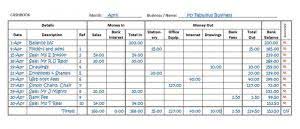
However, negative working capital could also be a sign of worsening liquidity caused by the mismanagement of cash (e.g. upcoming supplier payments, inability to collect credit purchases, slow inventory turnover). In such circumstances, the company is in a troubling situation related to its working capital. If a company’s change change in net working capital in NWC has increased year-over-year (YoY), this implies that either its operating assets have grown and/or its operating liabilities have declined from the preceding period. Cash and cash equivalents are not part of the core operations of a company’s revenue model, and are closer to investing activities (i.e. interest income).

The issue, however, is that an increasing accounts receivable balance implies the company’s cash collection processes might be inefficient, and a rising inventory balance means more inventory is piling up (and not sold). The rationale for subtracting the current period NWC from the prior period NWC, instead of the other way around, is to understand the impact on free cash flow (FCF) in the given period. A boost in cash flow and working capital might not be good if the company is taking on long-term debt that doesn’t generate enough cash flow to pay it off. Conversely, a large decrease in cash flow and working capital might not be so bad if the company is using the proceeds to invest in long-term fixed assets that will generate earnings in the years to come.
Everything You Need To Master Financial Modeling
The change in net working capital formula calculates how much the net working capital for a company has increased or decreased in the current period compared to the previous period or over a period of time. Understanding how changes in working capital can affect cash flows is important for a good financial model. Net working capital (NWC) is a metric to assess a company’s capacity to settle short-term debts. NWC is frequently used by accountants and business owners to swiftly evaluate the financial standing of a firm at any time.
It is calculated as the difference between current assets and liabilities on the balance sheet. If a transaction increases current assets and current liabilities by the same amount, there would be no change in working capital. It shows how efficiently a company manages its short-term resources to meet its operational needs. Positive change indicates improved liquidity, while negative change may signal financial difficulties.
What is the Net Working Capital Ratio?
It’s crucial to remember that current assets and liabilities have an expiration date. Current assets are accessible resources that can be converted into cash within a year, whereas current liabilities are obligations with an expiration date within the same year. This formula helps to evaluate whether a company’s net working capital has increased or decreased between the two periods. A positive change suggests improved liquidity and better management of short-term obligations, while a negative change could indicate potential liquidity issues.
If future periods for the current accounts are not available, create a section to outline the drivers and assumptions for the main assets. Use the historical data to calculate drivers and assumptions for future periods. See the information below for common drivers used in calculating specific line items. Finally, use the prepared drivers and assumptions to calculate future values for the line items. At the very top of the working capital schedule, reference sales and cost of goods sold from the income statement for all relevant periods.
Streamline your order-to-cash operations with HighRadius!
The change in net revenue is the difference between the ending and beginning balance. In the final part of our exercise, the incremental net working capital (NWC) will be calculated and expressed as a percentage. The net working capital (NWC) of the company is increasing by $2 million each period. In the next section, the change in net working capital (NWC) – i.e. the increase / (decrease) in net working capital (NWC) – will be determined. We’ll now move to a modeling exercise, which you can access by filling out the form below. Briefly, an increase in net working capital (NWC) is an outflow of cash, while a decrease in net working capital (NWC) is an inflow of cash.
- It tells us if a business has enough money to handle its daily expenses and to invest in its future.
- Working capital is important because it is necessary for businesses to remain solvent.
- Net working capital is a tool used by small business owners better to understand the current financial situation of their enterprise.
- It means that the company has enough working capital to easily pay its short-term debt and cover any additional financial obligations.
- It is calculated by subtracting the net working capital of the earlier period from that of the later period.